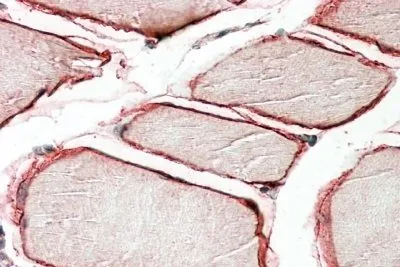
WB analysis of pig skeletal muscle (A) and heart (B) lysates using GTX88437 Caveolin 3 antibody, N-term. Dilution : 0.1microg/ml Loading : 35microg protein in RIPA buffer
Caveolin 3 antibody, N-term
GTX88437
ApplicationsWestern Blot, ImmunoHistoChemistry, ImmunoHistoChemistry Paraffin
Product group Antibodies
ReactivityHuman, Mouse, Porcine, Rat
TargetCAV3
Overview
- SupplierGeneTex
- Product NameCaveolin 3 antibody, N-term
- Delivery Days Customer7
- Application Supplier NoteWB: 0.1-0.3microg/ml. IHC-P: 3-5microg/ml. *Optimal dilutions/concentrations should be determined by the researcher.Not tested in other applications.
- ApplicationsWestern Blot, ImmunoHistoChemistry, ImmunoHistoChemistry Paraffin
- CertificationResearch Use Only
- ClonalityPolyclonal
- Concentration0.50 mg/ml
- ConjugateUnconjugated
- Gene ID859
- Target nameCAV3
- Target descriptioncaveolin 3
- Target synonymscaveolin-3; cavolin 3; LGMD1C; LQT9; M-caveolin; MPDT; RMD2; VIP21; VIP-21
- HostGoat
- IsotypeIgG
- Protein IDP56539
- Protein NameCaveolin-3
- Scientific DescriptionThis gene encodes a caveolin family member, which functions as a component of the caveolae plasma membranes found in most cell types. Caveolin proteins are proposed to be scaffolding proteins for organizing and concentrating certain caveolin-interacting molecules. Mutations identified in this gene lead to interference with protein oligomerization or intra-cellular routing, disrupting caveolae formation and resulting in Limb-Girdle muscular dystrophy type-1C (LGMD-1C), hyperCKemia or rippling muscle disease (RMD). Alternative splicing has been identified for this locus, with inclusion or exclusion of a differentially spliced intron. In addition, transcripts utilize multiple polyA sites and contain two potential translation initiation sites. [provided by RefSeq, Jul 2008]
- ReactivityHuman, Mouse, Porcine, Rat
- Storage Instruction-20°C or -80°C,2°C to 8°C
- UNSPSC12352203



